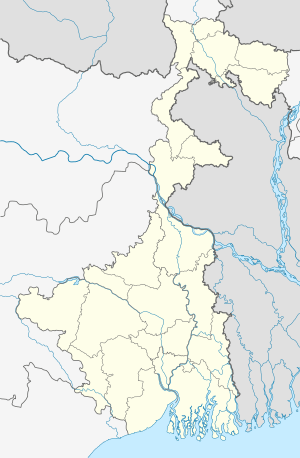Madhupur Satra
Madhupur Satra (Assamese: মধুপুৰ সত্ৰ) is a religious institutional center associated with the Ekasarana tradition of Vaishnavism,[1] situated in Cooch Behar, the Indian state of West Bengal.It is established by Assamese Vaishnavite monasteries for religious practices in 16th century during Koch kingdom.The great Bhakti Saint Mahapurusha Srimanta Sankardeva (1449-1568 AD) and his disciple Mahapurusha Madhavadeva died here.[2][3] Madhupur satra is also called as dahmukutor than ; 'dahmukut' means 'bhiti' or living houses of ten disciples (bhaktas) of Srimanta Sankardeva.The name satra originates in the Bhagavata Purana in Sanskrit (sattra), and is used in the sense of an assembly of devotees.[4]
| Madhupur Satra | |
|---|---|
 Madhupur Satra | |
| Religion | |
| Affiliation | Hinduism |
| District | Cooch Behar (West Bengal) |
| Festivals | Raasleela, Doul Utsav |
| Location | |
| State | West Bengal |
| Country | |
 Shown within West Bengal | |
| Geographic coordinates | 26.363537°N 89.378220°E |
| Architecture | |
| Creator | Nara Narayan |
| Completed | 16th Century (Approx.) |
| Inscriptions | Assamese |
| Website | |
| www.madhupursatra.org | |
Establishment
This satra buildings were built by 16th century's koch king Nara Narayan. After independence of India, Assamese chief minister Mahendra Mohan Choudhury rebuilt the houses, Namghar, roads with brick and mortar and built Sankardev's temple in January, 1968 with help of 'Madhupur Satra Samiti'.
Satradhikar
Monks, called "bhakats", live in satras under a "satradhikar" or "Mahanta". The main disciple of Srimanta Sankardeva was Madhavadeva.Before death of Sankardeva, he gave the responsibility to his disciple Madhavadeva (-1596 AD), to take care of the Satras. He laid down the system of daily prayer service and initiated the system of religious tithes.Later, Achyut guru, Shree Ram Ata, bishnu Ata became satradhikar of Madupur satra. After death of Bishnu Ata, 'Samuha' (bhaktas of some nearest villages) took responsibility of this satra. Later, Burhir-po Gobinda Atoi, Gopinath Atoi, Krishna Bapu Satriya, Ramnath Bapu Satriya, Gangaram Bapu Satriya, Pocharam vorali Atoi, Niron Atoi, Tolon Atoi, Lakshmikanta Atoi burha-bhakta, Fatik chandra dev Goswami took responsibility as Satradhikar.After death of Fatik chandra dev Goswami, Lakshmikanta Mahanta became Satradhikar of Madhupur satra in 18 April 2012.
Structures
The Satra is four-sided enclosed area with four gateways ("karapat"). Centrally placed in this enclosure is a rectangular prayer-hall ("Namghar" or "kirtanghar") at the aligned in the east-west direction. On its eastern side there is an additional independent structure called the "Manikut" (jewel-house), the sanctum santorum, in which the "asana", a wooden tetradehral structure with four carved lions), is placed containing the main object of worship (usually a copy of the Bhagavat Purana in manuscript or an idol). The "namghar" is surrounded by four straight rows of huts, called "hati", in which monks (bhakats) reside. The adhikara and other high officers of the Satra reside in the eastern "hatis".[5]
Cultural programmes
Some of the cultural programmes, which are held in Sattras:-
- Bhaona
- Doul utsav or Deul
- Janmastami
- Rasa lila or Raas utsav
- Sankardeva's birth anniversary celebration in October.
- First Satradhikar Gobinda Ata's death anniversary celebration in Magh (January–February) month.[2]
See also
- List of Satras
- Sattriya
- Barpeta Satra
- Dakshinpat Satra
Further reading
- Shree Shree Sankardeva O Shree Shree Madhavadeva – Writer: Lakshminath Bezbaroa
- Srimanta Sankardeva O teor jugor Boishnobacharyasakal – Dr. Shibnath Berman
- Mahapurush Srimanta Sankardebor Chomu Parichoy O Boikuntha Proyanor Sthan Shree Shree Madhupur (dham) Satrar Itibitto – Pitambar Ray Bhakta (Cooch Behar).
References
- (Sarma 1966, p. 101)
- "Madhupur Satra in India". India9.com. 4 October 2005. Retrieved 16 March 2013.
- "Road & Electricity". Cic.nic.in. Archived from the original on 5 March 2016. Retrieved 16 March 2013.
- (Neog 1980, p. 310)
- (Neog 1980, p. 309)
- Neog, Maheshwar (1980). Early History of the Vaishnava Faith and Movement in Assam. Delhi: Motilal Banarasidass.CS1 maint: ref=harv (link)